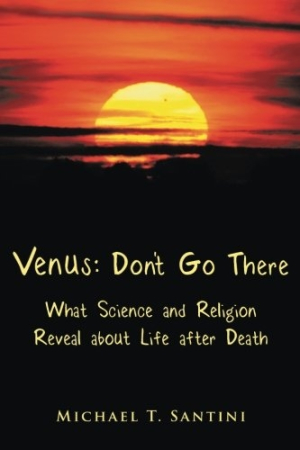Venus: Don't Go There
What Science and Religion Reveal about Life after Death
Venus: Don’t Go There is an uncommon and impressively composed examination of the topic of hell.
From aerospace engineer and Fuller Seminary graduate Michael Santini comes an interdisciplinary inquiry into one of the most controversial topics within theology: the existence of hell. By putting geology, astrophysics, and biblical criticism into conversation with one another, Santini’s Venus: Don’t Go There forwards adroit arguments not only for the existence of the biblical, eternal “lake of fire,” but also for its precise location.
Santini diligently presents all sides of his subjects. Regarding hell, he posits literal locations for both Hades (at the earth’s core) and for the more eternal destination of the damned—on the placid, lakelike, and incredibly hot surface of our neighboring planet. Yet he does not ignore other opinions on the topic, addressing the complications of hell-theories in relation to God’s eternal love. Santini’s awareness of and openness to differing perspectives is refreshing in a work of this nature.
So, too, are Santini’s scientific credentials. He presents, and ultimately rejects, young-Earth theories, insisting that there’s no reason to maintain a gulf between science and religion, not even in view of traditional interpretations of biblical cosmology. He maintains the truth of Genesis while also showing how its verses make room for accepting that our universe is billions of years old. Such passages, which discuss the stars and an expanding universe with a measurable life span, are written with both religious awe and academic intelligence.
This tendency to marry biblical literalism with modern science remains balanced throughout. Santini seems as comfortable discussing the work of Stephen Hawking as he is critiquing diverse religious writers, from Rob Bell to Tim LaHaye. A work that discusses science so capably is able to end with a testimonial without jarring its readers.
Santini’s voice is elegant, and his well-annotated, erudite, and religiously literate prose commands respect. He proves well-read on topics ranging from the origins of the universe to theories related to the mass of the soul. This uncommon mixture of evangelical conviction with the modern sciences warrants Venus: Don’t Go There a place among the more respected and academically conversant works of its genre. The book’s more creative forays, such as a late, science-fiction-esque dialogue between imagined souls on the eventual hell-planet, require some suspension of disbelief, but it’s likely that the book will encounter plenty of readers who are willing to take that leap.
Santini’s central thesis—that hell is a real, temporal destination, and that its precise (future) location is on Venus—presents the most continual challenge. Still, Santini argues even this creative supposition with seductive conviction, and capably employs scientific insights to back up his theories.
In the end, the author may do better a better job of persuading readers that Venus is hell-like, rather than that it is hell itself. Santini openly admits that other places in the universe may fit the bill. But whether or not readers are convinced that Santini has perfectly mapped the afterlife, they’re certain to respect his research and creativity. Venus: Don’t Go There is an uncommon and impressively composed examination of the topic of hell.
Reviewed by
Michelle Anne Schingler
Disclosure: This article is not an endorsement, but a review. The publisher of this book provided free copies of the book and paid a small fee to have their book reviewed by a professional reviewer. Foreword Reviews and Clarion Reviews make no guarantee that the publisher will receive a positive review. Foreword Magazine, Inc. is disclosing this in accordance with the Federal Trade Commission’s 16 CFR, Part 255.

